Colder weather is coming, but don’t pack away that telescope just yet. You’d miss a powerful storm that’s remaking Jupiter’s North Temperate Belt, a returning comet, Mira on the rise, and a bright supernova in the Great Bear.
Storms on Jupiter

Enhanced Image by Gerald Eichstädt and Sean Doran (CC BY-NC-SA) based on images provided courtesy of NASA/JPL-Caltech/SwRI/MSSS
Fresh storms are brewing in Jupiter's northern hemisphere that will soon alter the appearance of one of its most distinctive features. Japanese observer Isao Miyazaki reported a bright outbreak in the planet's North Temperate Belt (NTB) on August 18th that has subsequently blossomed into a chain of raging storms stretching at least halfway across the planet. NTB outbreaks are among the most dynamic and energetic on the planet, announcing themselves as one or more brilliant, compact plumes along the southern edge of the NTB.
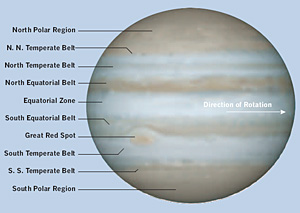
Sky & Telescope
The plumes originate from storm systems deep within Jupiter's water clouds that punch their way to the upper cloud deck and inject fresh ammonia ice and water 30 kilometers above the visible clouds. The southern edge of the NTB hosts one of the fastest jet streams on the planet with winds of 600 kilometers per hour (370 mph). The material interacts with the jet to create a great wave of dark storms and red aerosols that ultimately merge into a revived, orange-hued NTB.
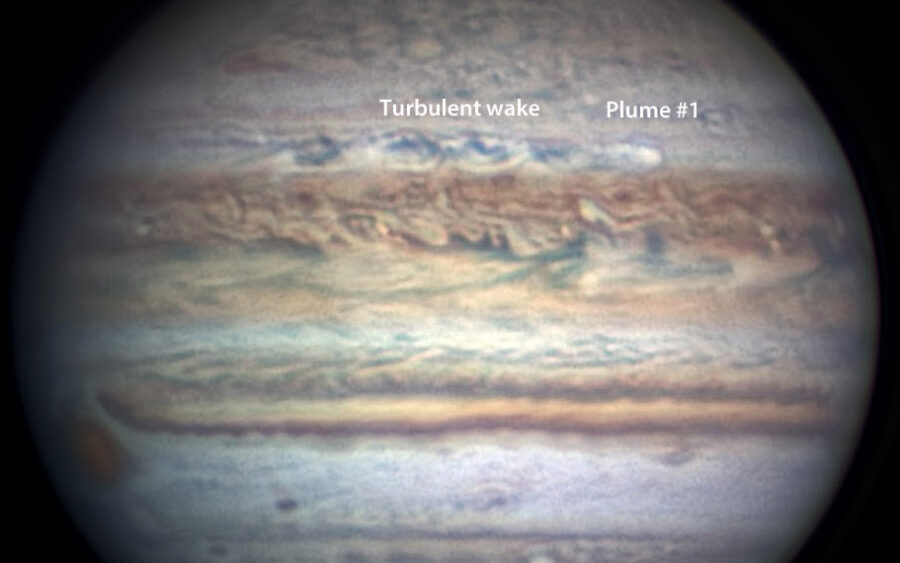
Christopher Go
Evolving Storms
In Tom Polakis's images we can clearly see the first plume, dubbed NTB Outbreak #1, and the evolving trail of dark storm clouds in its wake. Two other smaller plumes (not shown here) are also contributing to the disturbance. Based on previous outbreaks in 2007, 2012, and 2016 we'd expect the ongoing tempest to revive the NTB in a matter of weeks or months. My attempts to see the outbreak have been unsuccessful as of this writing due to poor seeing.
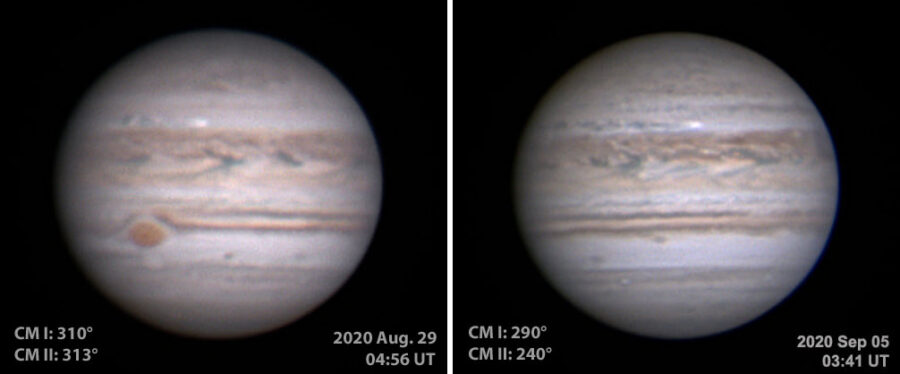
Tom Polakis
Amateurs are strongly encouraged to keep track of the rapidly evolving storms. That can be a little tricky because Jupiter isn't a solid body — it spins differentially, similar to the Sun. Atmospheric features at polar latitudes take about 5 minutes longer to rotate than those at equatorial latitudes. Hence we invoke two systems for plotting longitudes — System I for latitudes 10°N to 10°S and System II for temperate and polar regions.
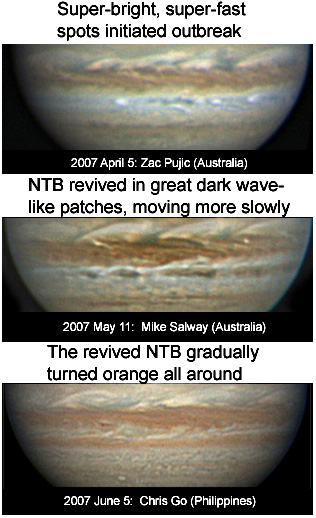
Courtesy of John Rogers, Jupiter Section Director, BAA
The primary plume maintains a steady latitude around 24°N, but it's whooshed along by that powerful jet stream, decreasing its longitude at the rate of –4.9°/day in System I and –12.5°/day in System II. It blew by the Great Red Spot on August 27th and will lap it again on September 25th.
Join the Chase
Your best chance to see the plume and its stormy entourage is when they're near Jupiter's central meridian (CM), the line running north-south down the middle of the planet. To determine the CM's longitude when you plan to observe go to the Tau Astronomy Club's Jupiter Map and Central Meridian page or download the free Meridian program for Windows.
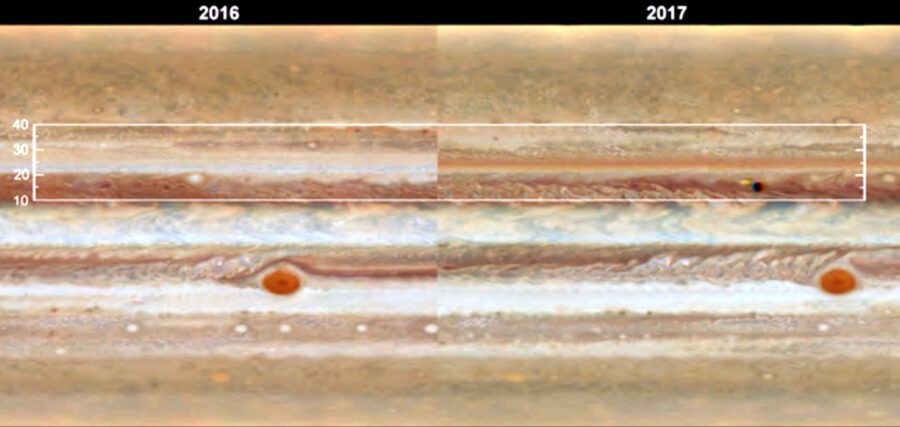
NASA / ESA
Here are some approximate Sys. II longitudes of the primary plume pictured in the coming days — Sept. 9 (172°); 10 (159°); 11 (146°); 12 (133°); 13 (120°); 14 (107°); 15 (94°) and 16 (81°). Use Meridian or the online calculator to determine when the plume's longitude will be near the CM for your location. Your best views will be within an hour of either side of meridian passage.
"Each plume is expected to collapse and probably disappear when it encounters the wake of the preceding plume," writes John Rogers, Jupiter Section Director of the British Astronomical Association, in an e-mail communication. "What remains is a chaotic dark new NTB(S) [south component of the NTB], which turns orange within a few months."
Exciting stuff! If you spot the plume and emergent NTB we'd love to know. Please drop us a line in the comments section.
Comet Howell Keeps Things Hopping
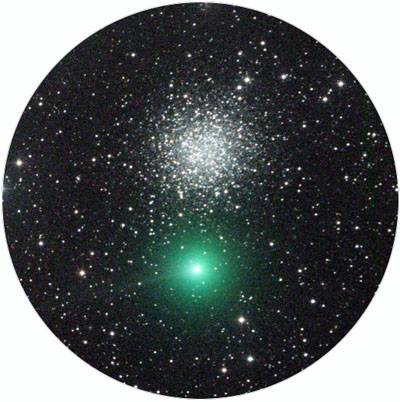
Martin Mobberley
I miss Comet NEOWISE. I miss the euphoria of all those nights of little sleep and wide-eyed wonder watching a frosty flower bloom and fade. The comet still lingers low in the western sky at dusk in Virgo, but it's a shadow of its former self at magnitude 9.5 and just a few arcminutes across.
In the meantime, periodic comet 88P/Howell has stepped up to the plate. Returning to Earth's vicinity every 5.5 years it reaches perihelion this apparition on September 26th. Currently at magnitude 9 with a moderately condensed coma 3.5′ across, the little cotton wad is low in the southwestern sky in Libra at the end of dusk. It may get as bright as 8th magnitude by month's end, putting it within binocular range.
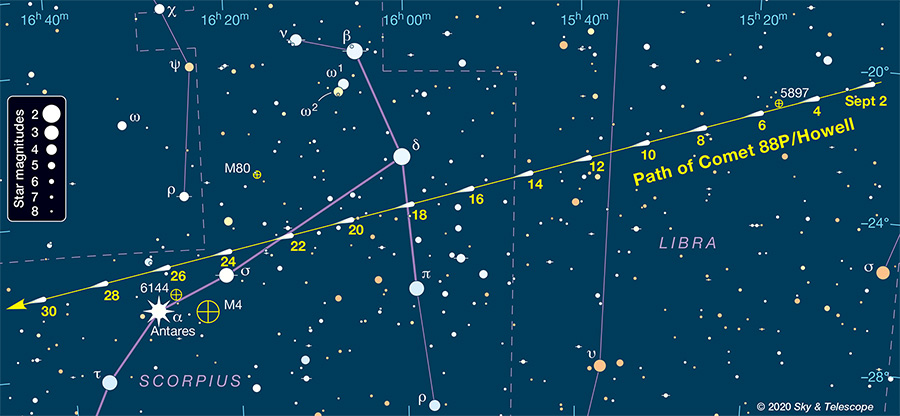
Sky & Telescope
A wide-open view to the southwest will be key to seeing the comet. For observers in the northern United States, Comet Howell stands barely 5° high at the end of dusk. Farther south, viewing circumstances improve; from New Orleans it's more than 15° high at nightfall and an easy catch in an 8-inch scope from a dark site. On the nights of September 25th and 26th the comet passes just 1° north of Antares.
Bright Supernova Below the Dipper's Bowl
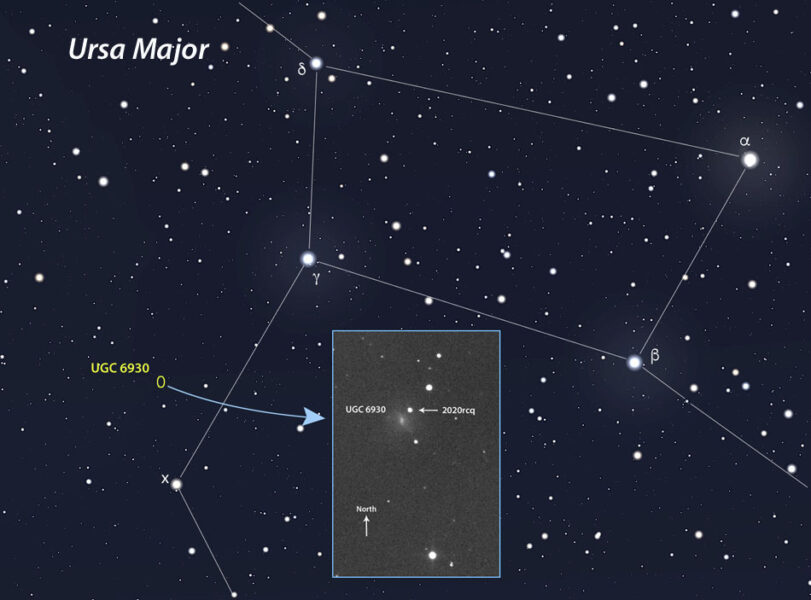
Map: Stellarium; inset: Gianluca Masi
At the opposite end of the sky under the belly of the Great Bear you'll find one of the year's brightest supernovae, SN 2020rcq. It's located 26.1″ west and 32.9″ north of the center of the 13th-magnitude galaxy UGC 6930. On August 25th, the Type Ia explosion peaked at magnitude 11.8 and continues to shine brightly at 12.4 (September 3rd).
I couldn't believe how easy it was to see the supernova in my scope on the 25th, completely outshining its faint host galaxy. With the Moon now out of the sky I encourage you to have a look while it's still in the 12th-magnitude range.
Admiring Mira
Mars has company. Not far below the Red Planet you'll spy the red eye of Mira, the best known pulsating red giant star and prototype of the Mira variables. Instabilities in the giant's core cause the star to expand and contract and vary in brightness over a period of 332 days. At minimum, Mira dips to magnitude 10, but it can shoot all the way up to 2 during a bright maximum.
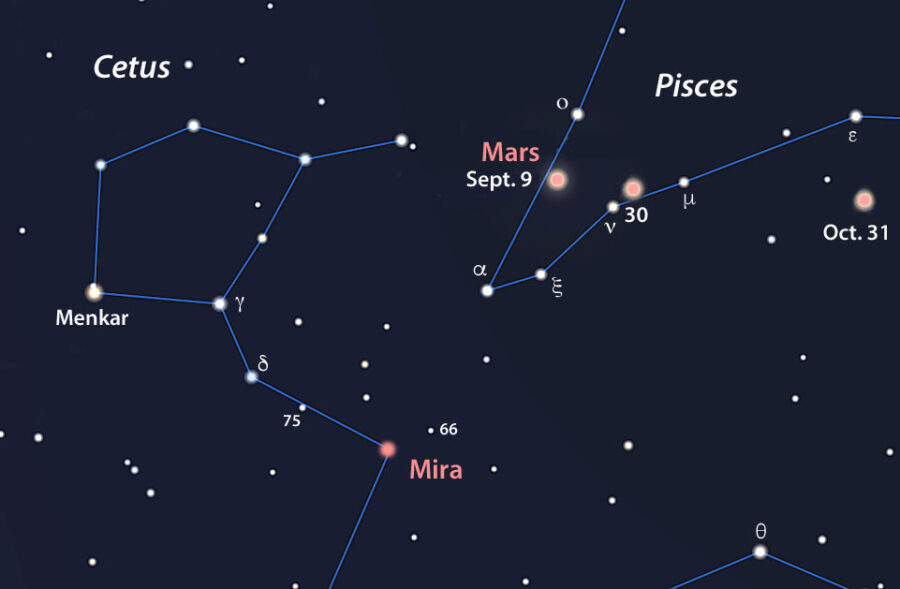
Stellarium
A couple weeks ago when I rose to hunt morning comets I noticed that Mira was back in view at magnitude 4.5. It's been climbing ever since and currently shines around magnitude 3.8. Peak brightness is forecast for October 6th. Because maxima vary from cycle to cycle you never know exactly what to expect, making each one special. Last October, for example, Mira peaked at magnitude 2.8.
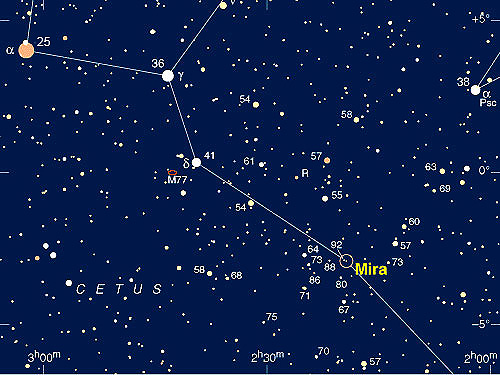
Use the chart and the magnitudes provided to help you track Mira's ups and downs through the fall and winter. If you have a visual spectroscope it's one of the most rewarding objects in the sky. Unlike hotter stars, which display only a few hydrogen absorption lines, Mira's spectrum is rich in heavier elements and even molecules, including bands of titanium oxide.
Other highlights this week include Neptune's opposition on September 11th and Venus passing south of the Beehive Cluster between September 11th and 13th. Wishing you happy nights.
 8
8









Comments
Rod
September 9, 2020 at 1:26 pm
Bob King, very good report here. I did not know about the NTB storm on Jupiter until this report. The evening of 05-Sep I was out enjoying Jupiter using my 10-inch Newtonian at 86x to 120x views using a green filter to observe the Great Red Spot coming into view and crossing the central meridian near 2218 EDT as reported in "THIS WEEK'S SKY AT A GLANCE, SEPTEMBER 4 – 12"
Mars is really strutting about now and very good to view, even in my 90-mm refractor telescope at 200x with or without filters. I look forward to a Bob King, Mars opposition campaign report for October :)---Rod
You must be logged in to post a comment.
Bob KingPost Author
September 9, 2020 at 1:55 pm
Hi Rod,
Thank you! And I'd (we'd) very much enjoy hearing if you see either the white plume or the fresh start of the NTB.
You must be logged in to post a comment.
Chris-Schur
September 10, 2020 at 7:01 pm
Nice report Bob, we got out before the smoke hit Arizona this weekend and saw Comet Howell briefly in Libra very low in the south west in an 8 inch at low power. While there is no really good tail on this one, the bright teal colored head is a nice photo target! Chris Schur
You must be logged in to post a comment.
Bob KingPost Author
September 16, 2020 at 7:33 pm
Hi Chris,
Glad you caught before the smoke arrived. I tried for it here in Duluth but it was simply too low at the end of twilight for me to confirm.
You must be logged in to post a comment.
Thomas Aquinas
September 10, 2020 at 11:50 pm
I'm one of the planetary exploration devotees that visited the 'shrine' in Pasadena, CA and stayed awake for all the Voyager fly-by's. A minor complaint is the very common tendency of publications to use 'artificially enhanced' photos of the planets, especially Jupiter. Indeed, the movie 2010 actually showed nothing but the NASA recreation of Jupiter with special filters. Most people now are surprised when they find out that Jupiter is not a technicolor poster but a pale planet in real light...
You must be logged in to post a comment.
Bob KingPost Author
September 16, 2020 at 7:34 pm
Hi Thomas,
That's one of the reasons I wanted to include Tom's images — they more closely resemble the telescopic view.
You must be logged in to post a comment.
Jakob Sauppe
September 14, 2020 at 2:52 pm
This is such a great summary of night sky happenings right now. Thanks so much, Bob! Our observatory in Lynchburg, VA is going to attempt to photograph Comet Howell tonight and tomorrow night if it proves to be high enough on the horizon.
You must be logged in to post a comment.
Bob KingPost Author
September 16, 2020 at 7:32 pm
Hi Jakob,
Thank you and good luck with your photos. Hopefully, the wildfire smoke won't be an impediment.
You must be logged in to post a comment.
You must be logged in to post a comment.